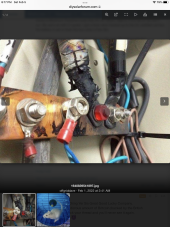Timtumm
New Member
- Joined
- Oct 20, 2021
- Messages
- 10
In case it matters, I have already bought 4 3.2V-280Ah batteries. They look good.
The very small RV build (on a short, 118"-wb Promaster) should need very little power (only for lights, a fridge, a fan, and
1. Every body is using the Victron 121230 DC-DC convertor/isolator. But is is so expensive (over $200). I have been buying cheaper stuff for everything else, and hate to pay almost as much for this usage as I did for the batteries themselves. Is there a cheaper alternative?
2. I also cheaped out, and bought a dinky BMS, which looks way too small now that it has arrived (2"x2.5"). I guess size is not everything, but there is no documentation. The marking on it are:
4S 120A 3.2V BMS Connections: Same Port (whatever that means)
Charge Current Max 60A Working Current: Max 120A
Heltec-BMS.com SKU 0914 Heltec BMS
Can I use this? I ask because it only has 4 power wires for the batteries, and I also expected a 5th for the ground.
2A. If I can't use this BMS, any recommendations for a cheap BMS?
3. Any recommendations on an inverter? I am assuming 1000-2000 watts for charging laptops. I also assume that because of this, it needs to be full sine wave.
The very small RV build (on a short, 118"-wb Promaster) should need very little power (only for lights, a fridge, a fan, and
1. Every body is using the Victron 121230 DC-DC convertor/isolator. But is is so expensive (over $200). I have been buying cheaper stuff for everything else, and hate to pay almost as much for this usage as I did for the batteries themselves. Is there a cheaper alternative?
2. I also cheaped out, and bought a dinky BMS, which looks way too small now that it has arrived (2"x2.5"). I guess size is not everything, but there is no documentation. The marking on it are:
4S 120A 3.2V BMS Connections: Same Port (whatever that means)
Charge Current Max 60A Working Current: Max 120A
Heltec-BMS.com SKU 0914 Heltec BMS
Can I use this? I ask because it only has 4 power wires for the batteries, and I also expected a 5th for the ground.
2A. If I can't use this BMS, any recommendations for a cheap BMS?
3. Any recommendations on an inverter? I am assuming 1000-2000 watts for charging laptops. I also assume that because of this, it needs to be full sine wave.
Last edited:





